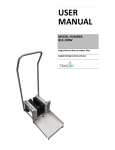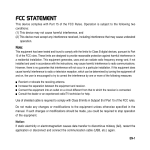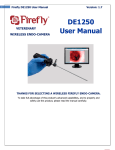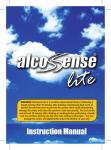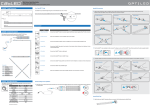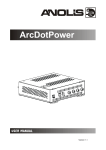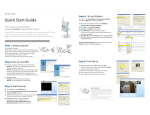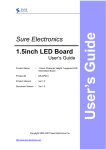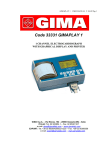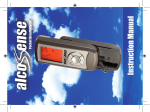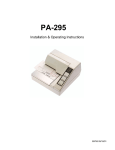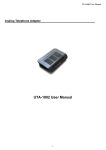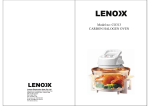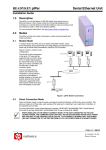Download User`s manual
Transcript
Pro-termo doo Instructions for installation and use of solid fuel burning stove The efficiency of the stove depends on the proper installation, which must be done by qualified personnel following the standards and current safety regulations. The choice of location where the stove is to be installed should be made accordingly so that there is a free flow of air and to make sure that surrounding objects and floor are noncombustible. Keep in mind the strength of the floor. If the floor cannot support the weight of the stove, it is necessary to strengthen the floor or to support the stove with sturdy legs in consultation with qualified personnel. The minimum clearance between the front of the stove and combustible material is 40cm (15.7inches), and the minimum clearance between the sides of the stove and combustible materials is 40cm (15.7inches). The minimum clearance between the back of the stove and combustible materials is 30cm (11.8 inches) The steel parts of the stove are protected by a high temperature resistant colour. During the first couple of uses the smoke and smell will appear as the result of the stabilisation of colour. The room in which the stove is placed should be ventilated. The stove is constructed to operate with closed doors. The door should only be opened if there is a need to add more fuel. You should open the door slowly in order to balance the pressure. A quick opening of the door can result in sucking out the flame and smoke. Fuel should be added only if ember is formed. Be cautious as the stove heats up and becomes extremely hot. Children should not be allowed to operate and play around the stove. Enable constant flow of fresh air for combustion. Do not place flammables into the fuel-chamber or on any other parts of the stove. Do not allow parts of the stove to become red-hot. Do not use the stove for combustion of litter, inadequate and not recommended fuel. The packaging of the stove should be placed in an appropriate location. Parts made out of carton, wood or plastic which are made for the fuel-chamber should be taken out before the use of the stove. IN CASE OF NOT FOLLOWING THE INSTRUCTIONS THE MANUFACTURER IS NOT RESPONSIBLE FOR ANY DAMAGE WHICH MAY OCCUR. 1. STOVE FUNCTIONS 1.1. Description of the stove The stove is made for heating closed spaces. The glass on the door of the fuelchamber and the steel parts of the stove radiate the heat. The parts of the stove are made out of cold rolled steel, and the glass on the door of the fuel-chamber is high temperature resistant. 1.2. Installation Acquire the help of qualified personnel who are informed about the safety regulations in terms of stove installation. A faulty installed stove can lead to accidents (a fire explosion in the chimney, combustion of isolation materials, etc.). 1.3. First use of the stove Upon first use of the stove there is appearance of smoke and smell which comes from the protective colour. This is normal as during high temperatures at over 350°C there is a stabilization of color. IT IS NECESSARY TO VENTILATE THE ROOM. Before lighting the stove, dust and all other unhygienic substances should be wiped off with a dry cloth. During the first lighting of the stove the amount of fuel should be reduced to half of the recommended amount, in order to properly test the working efficiency of the stove. 2.4 Ventilating the room in which the stove is located Proper ventilation of the room is essential for the stove to function efficiently, without being a risk to the inhabitants of the room, as during use the stove uses up oxygen in the air. It is essential that the room has air intakes which have controllable outputs. WARNING In case of not following the instructions, the manufacturer does not take any responsibility. No modifications can be made on the stove. 2. CHIMNEY Special attention shall be placed upon the quality of the chimney, which must be constructed according to proper standards. The chimney should be regularly cleaned. The stove is connected to the chimney via a fitting which is located on the top or on the back part of the stove, with an appropriate flue pipe, so as to ensure tightness and flow of smoke from the stove towards the chimney. The flue pipe should not be inside the chimney to deep, to make sure that it doesn’t reduce the space of the cross section and in this way breach the draft in the chimney. Flow of Air Inadequate flow of air is the reason for most complaints about the stove not working efficiently. The required draft needed for this stove is 10 Pa. Lower value doesn’t allow for proper combustion, and this can result in creation of carbon deposits and too much smoke which cannot escape to the outside but rather through the grid and the door. If the value of the flow of air is too high, combustion will occur too quickly, and the heat will escape through the chimney. The signs for poor air flow are: - Dirty glass on the door, hot handle - Smoke which is escaping from the stove into the room 3.1 General characteristics For an easier flow of air in the chimney, the chimney should be at least one meter above the edge of the roof. The chimney should not be obstructed by other neighbouring objects. The dimensions of the chimney can vary based on its model. However, in order to ensure good implementation of smoke, the part of the chimney designed for the escape of air on the chimneys exit, must always be twice as big as the space of flue pipes, and the lid of the chimney should never interfere with air flow. The chimney secures the escape of smoke even when there are strong horizontal winds and when there is bad weather which restricts the escape of smoke. Inadequate maintenance of the chimney can be the cause for poor smoke escape due to breakage or crumbling of mortar, bricks and other materials which constitute the chimney, as well as layers of combusted materials and other foreign objects which may have fallen inside. The chimney must be thermally insulated, otherwise condensation occurs. The inside parts of the whole chimney should have a smooth surface, and the used materials should be temperature and chemical resistant to the products for combustion. 3.2 Reccomendations for the chimney The chimney must be smooth on the inside, impermeable to gases through the material with thermal insulation. Height of the chimney Round (diameter) cross-section Rectangular cross-section 5m 10 m 15 m cm. 20/22 cm. 18/20 cm. 15/16 cm. 20 x 20 cm. 18 x 18 cm. 16 x 16 3.3 Connecting the stove to the chimney The metal pipe which connects the stove with the chimney should not have a smaller diameter than the outlet on the stove. Try to avoid too many curves and horizontal sections; if this is not possible, make sure that there is always a slope of at least 2/3 cm per meter. The chimney to which the stove is conncted no other appliances should be connected which use gas fuels. Do not shorten the diameter of the chimney by inserting the pipe too deep which connects the stove to the chimney, inside the chimney. 3.4 Cleaning of the flue pipes and the chimney Everytime you notice that the flow of air has been reduced, you should clean the stove, the flue pipes and the chimney. Removing remnants of soot and unburned fuel should be done using the extra accessories and protective equipment. The cleaning should be done when the stove is cold. The pipe for the connection with the chimney should be as short as possible, and the point of attachment should be hermetic. The connection with the chimney must be done with strong and stable pipes. The pipe for the escape of smoke must be hermetically connected to the chimney. WARNING: Flammable parts which are distanced 20cm or less from the pipe should be replaced with materials resistent to fire and high temperatures. For the stove to operate efficiently, it is essential that the space at which the stove is installed has enough air for combustion. This means that through air openings, air must circulate in order for combustion to occur, even when the doors and windows are closed. Draft in the chimney should be 12 Pa – Measurement should occur when the stove is hot. When draft exceeds 15 Pa it is essential to reduce the draft by insatlling additional valves for controling draft on the exhaust pipe or on the chimney. 3. Wood Use only dry wood! Not only should wood be of high quality, but it should be dry in the moment of use. Bear in mind, that the calorific value of wood is reduced when wood is moist, because the presence of moisture means that much produced heat is used up for the moisture to evaporate, furthermore it creates the risk of asphyxiation. The reccomended moisture of wood is 20%. 4.1 Drying Moist wood not only burns poorly, but also makes it hard for lighting fire and damages the chimney. Aerated water transports the condensates, such as acetic acid, alcohol, methyl alcohol and tar which contribute to the layers of deposit which are harmful to the stove and the chimney. Freshly cut wood is bad as a source of fuel. A great amount of energy which it produces goes into water vaporization, because the moisture of young wood without tree bark is around 75%. In order to get dry wood (with 15-20% moisture), it must be cut during winter to a desired length and also cut into pieces with a maximal diameter of 8-15cm. The wood then needs to be put into a closed space with ventilation for at least 2 years (4 for oak, but first must be exposed to rain in order to eliminate tannin). The wood must be arranged in a way so that there is air flow which circulates through the logs and frees moisture. 4.2 Recommendations for proper choice of fuel wood NEVER USE: Green or moist wood, already used wood for other purposes (painted and oiled wood, wood from railroads, scrap plywood etc.), and very caloric coal. THE USE OF THE ABOVE MENTIONED MATERIALS AND THE DAMAGE WHICH THEY CAUSE, CANCEL THE WARRANTY, SO THE MANUFACTURER IN THESE CASES TAKES NO RESPONSIBILITY. 4. Cleaning of the stove We recommend that you clean the ash from the stove every day. Never allow for ash deposition to reach the surface of the grid, this would interfere with the circulation of primary air and would cause the fire out. During cleaning of external parts of the stove do not use abrasive products which would damage the paint. The glass of the fuel chamber should be cleaned only when cold. Do not use abrasive products because you will damage the surface of the glass. After cleaning wash it out with clean water and dry. The models with ceramic tiles, detergents should be used for cleaning, as well as water, a soft cloth which won’t cause damage to the glaze. 5. CONSUMER ITEMS The following items are considered as consumables and are not covered in the warranty: All sealants, parts of glass, paneling on the fireplace, ceramics and parts with chemical plating (chrome, nickel and galvanized parts). Warranty does not cover damages which occur due to improper installation, improper connections which are not according to the instructions received with the appliance, or damages made by unqualified or unauthorized personnel. 6. RECOMMENDATIONS FOR SEASONS WHEN THE STOVE IS NOT IN USE After cleaning the fuel chamber, flue pipes and the chimney, trying to get rid of all ash and other remaining materials, you must close the door of the fuel chamber and its regulators; in case of disconnecting the stove from the chimney, you must close the chimneys outlets so that other appliances connected to it can function properly. The cleaning of the chimney should be done at least once a year. Check the state of the sealants and if need be replace them. If there is moisture present in the room where the stove is located, we recommend you place materials which dry air inside the fuel chamber. 7. PROCEDURE IN CASE OF IRREGULARITIES 8.1Difficulties in the working operations of the stove - Check if the entry connection of the chimney is properly done. Check if the dimensions of the chimney are correct for the stove. Check if the chimney is properly thermally insulated and constructed according to standards. The door of the stove must be properly closed. 8.2 Difficulties in lighting the fire in the fuel chamber - Open the primary regulator of air and smoke Use dry wood Ventilate the room for constant air flow and sufficient amount of oxygen The chimney must see fit to the appliance which is being used 8.3 Escape of smoke - Check if the regulator for primary air flow is open Check if there is leakage upon chimney entry Check if ash or any other remains have clogged the pipes or the grid Check if the air flow is sufficient Check the draft in the chimney Check the sealants 8.4 Stains on the glass - Moist wood: use dry wood (with max: 20% moisture) Wrong fuel (see allowed materials) Too much fuel in the fuel chamber Insufficient air flow Wrong regulations: if the secondary regulator is closed, the glass gets stained very quickly. 8.5 Condensation - During first uses condensation is normal, because the internal parts contain moisture If the problem seems ongoing, check the wood you are using. It should not be moist or improperly dried. The chimney should not have defects and should not cool the gas too quickly. Note: During the manufacturing of the stove, the materials used ARE NOT health harmful. The manufacturer holds rights to modify the appearance, dimensions or modify the model of the appliance without prior notice. 8. TECHNICAL DESCRIPTION 9.1 Description The stove is designed for heating homes or as a supplement to insufficient heating. As a source of fuel it is possible to use wood logs. The stove is made of cast iron and plate steel. The internal parts of the fuel chamber is secured by one layer of plate steel, inside is also a grid which can be used for turning and can also be taken out. The stoves door has a glass (which is resistant to temperatures of up to 800°C) and enables a view of the flame. Heating up of spaces is achieved by: Through the glass and external surfaces of the stove, heat transfers into open space. The stove with the chimney has regulators of primary and secondary air, by which the combustion of air is controlled. 9.2 PRIMARY control of air Primary air is essential for the process of combustion. The drawer with ash must regularly be emptied, so that ash doesn’t interfere with the entry of primary air. Through primary air, the fire is kept alive. During combustion of wood, the regulator for primary air must be open only when needed (starting the fire, increasing the intensity of burning), otherwise the wood will burn quickly and the stove may overheat. 9. INSTALLATION The stove must be connected to an adequate chimney. The connection if possible should be short, straight or a little upwards. The connections must be tight. It is a must to follow National and European regulations, local regulations which refer to construction and fire fighting regulations. We ask that you refer to you local chimney sweeper for more information. There has to be a sufficient amount of air coming through to the place where the stove is installed in order to achieve combustion. The diameter of flue pipes for connecting must at least fit the diameter of the port where the smoke escapes (Ø120 mm). The port must have a wall connection for receiving the exhaust pipe. Before installation, check if your floor can support the weight of the stove; if it cannot support the weight of the stove take appropriate measures to increase the weight which your floor can support. The manufacturer is not responsible in case of modification of the appliance and in case of need to use unoriginal reserve parts. 10. FIRE SAFETY During the installation of the stove, the following safety regulations should be followed: A) In order to ensure a sufficient thermal insulation, the minimal precautions in terms of distance between furniture and other objects which are flammable must be followed; this includes all furniture and objects made out of wood as well as flammable fabrics etc.). All minimal safety distances must be respected and lower values SHOULD NOT be considered. B) In front of the stove there should be no flammable objects or materials, or anything sensitive to heat at a distance of less than 100cm. C) If the stove is installed on a floor which is totally resistant to fire, you must take into account the surrounding which is resistant to fire, for example, the steel platform which must have the dimensions in accordance with local regulations. D) Above the stove, there should be not flammable materials. The stove must operate with the ash drawer in place. Solid remains of combustion (ash) must be compiled into a tray resistant to fire. The stove should never work if there is emission of gas or vapour (e.g. glue, petrol etc.). Never leave flammable material in close distance to the stove. During combustion, the heat spreads out and heats up surfaces, the door, and the glass on the door, handles and buttons, the chimney and the front part of the stove. Please avoid making contact with these parts without gloves or other appropriate equipment. Warn children about these dangers, and keep them away from the stove when it is working. The use of wrong or moist fuel can cause layers of creosote in the chimney and this can lead to fire in the chimney. FISRT AID MEASURES In case of emergency in the chimney: a) Close doors b) Close air regulators for combustion c) Shut out the fire using CO2 in powder form DO NOT SHUT OUT THE FIRE USING A WATER HOSE. When the fire is out, the chimney must be checked by qualified personnel so that any potential damages can be found. 11. ENTRY OF AIR AT THE POINT WHERE THE STOVE IS INSTALLED DURING COMBUSTION As stoves get the air necessary for combustion from the place of installation, it is essential that a sufficient amount of air gets into the room where the stove operates. In case of hermetic doors and windows (for example in houses constructed to keep heat inside) it may occur that the entry of air isn’t guaranteed, which brings into question the flow of air, and the safety of people inside the household. It is necessary to guarantee the sufficient amount of air through the external air opening, which should be located close to the stove or it should be provided via an air connection inside or close to the room with ventilation. The entry of air needed for combustion at the point where the stove is installed should not be closed while the stove is working. It is absolutely essential that there is enough air in the room where the stove is working. There should be enough air for combustion, up to 20m3/h. A hood which is installed in the room causes depression with the exhaust gases of combustion (smoke, smell). As a result, it is necessary to ensure a greater flow of fresh air. The depression in the hood can suck in the smoke with dangerous consequences for people. 12. ALLOWED/NOT ALLOWED FUEL Allowed fuel includes wood logs, briquettes of wood and coal. Only dried wood logs should be used (moister of up to only 20%). 2 to 3 logs should be placed at one time, no more. The length of wooden logs should be 30-40cm with a maximum circumference of 30-35cm. Moist wood makes it hard to start a fire, because there is a greater amount of energy required to evaporate the presence of water. The presence of water makes for higher levels of condensation in the hearth and also in the chimney. Also, the following should not be lit: remains of coal, remains of tree bark, moist or lacquered wood, plastic materials, materials with an organic background; in these cases the warranty for the appliance is cancelled. Paper and cardboard may only be used when first lighting the fire. Lighting of wastes is FORBIDDEN and can damage the stove and the chimney, as well as cause health problems and a spread of bad smell. Wood is unable to constantly burn as it burns out, so as a consequence heating is not possible for the duration of the whole night. NOTE: The continuous use of aromatic wood damages the parts of cast iron. 13. LIGHTING IMPORTANT: When the stove is used for the very first time, there will be a smell which disappears after the stove operates for a while. Nevertheless, the room should be adequately ventilated. During the very first lighting, we recommend putting a smaller amount of fuel and a steady increase of temperature. Smell and smoke are a regular appearance which occurs due to stabilization of color which protects parts of the stove, and this is why the room should be provided with a constant flow of air. During the process of lighting, these rules should be followed: 1. Check if these is a sufficient amount of air flow circulating around the spot where the stove in located. 2. During the first couple of uses do not overfill the combustion chamber (not more than half the amount recommended in the manual) and keep the fire burning 610 hours constantly; the regulators should be less open in comparison with the allegations in the manual. 3. Repeat this operation 4-5 times or more. 4. Later on you can increase the amount of fuel (in accordance with the maximal amount recommended in the manual) and keeping the fire burning for extended periods. 5. During first lightings do not put any objects on the stove or into contact with the protective color on the surfaces. 6. After you have finished with the run-in of the stove, you can begin to use it based on the instructions, without overheating by putting too much fuel. For starting a fire, we recommend you use small pieces of wood with paper or any other material appropriate for starting a fire. NO LIQUID SUBSTANCE should be used (alcohol, petrol, oil, etc.). Working with wood: Open the primary and secondary controls of air and light the fire. After the fire has been running for 10-15 minutes, close the primary regulator and set the desired mode. Air openings (primary and secondary) must be opened together only until the stove has been working at a desired level. Never overload the stove. Too much fuel and air for combustion can cause overheating and can damage the stove. 14. REGULAR OPERATION IMPORTANT: keeping in mind that the door of the stove is big; we recommend that you open the door very slowly, in order to avoid the escape of smoke and flame. For safety reasons, the door of the combustion chamber can be opened while the stove is working only to add fuel. The combustion chamber door otherwise, must always remain closed. Before opening the door, the primary air regulator should be opened, the door should be opened slowly, fuel should be placed inside, and after 5-10 minutes the primary regulator should be closed. Emission of heat is controlled with the help of a regulator which can be found at the front of the stove. The regulator can be opened when needed. The best combustion occurs when the sufficient amount of air passes through the secondary regulator of air. Never overload the stove (compare the table with the technical statistics – the maximum amount of fuel). The warranty does not cover damages caused by overheating. Always use the stove with closed doors, so as to protect the surrounding should it overheat. Apart from controlling the air flow for combustion, the intensity of combustion and the caloric value depend on the chimney. A good chimney requires a lesser control of air for combustion. In order to check for combustion, check the smoke escaping through the chimney. If it is grey or black, it means that combustion isn’t complete (a greater amount of secondary air flow is required). 15. OPERATION IN THE INTERIM PERIOD During interim periods, when outside temperatures are higher, or if there is a sudden change in temperature, it can occur that the gases of combustion inside the chimney cannot fully escape. When the gases do not fully escape (an intense smell of gas), the grid should be shaken more often and the air flow for combustion should be increased, also lesser amounts of fuel should be used in order to stabilize the flow of air. Check if the openings for cleaning and the connections with the chimney are well closed. 16. CLEANING The installation of the stove, the connection with the chimney and the ventilation ought to be checked by your chimney sweeper. For the cleaning of colored surfaces use soap water or non aggressive, neutral and non-abrasive chemicals. Glass should be cleaned with detergents, water, and before the use of the stove, the glass has to be dry. Do not use abrasive chemicals which damage the surface of the glass. IMPORTANT: It is only possible to use reserve parts if they are approved by the manufacturer. In case needed, please contact our dealer. THE APPLIANCE SHOULD NOT BE MODIFIED WITHOUT THE MANUFACTURERS APPROVAL. Regularly clean the stove, pipers and the chimney. 17.1 Cleaning the chimney Proper lighting, using of appropriate fuel, placing an appropriate amount of fuel in the fuel chamber, proper adjustments of the secondary air control, sufficient air flow in the chimney and the presence of air for combustion, are all key points in order for the stove to function efficiently. The stove must be completely cleaned at least once a year, or every time when it is needed (in case of poor performance). Cleaning should be done only when the stove is completely cold. This should be done by a chimney sweeper, who can at the same time observe the chimney (looking for possible layers of deposit). During cleaning, it is necessary to put away the ash drawer and the pipes for the smoke. 17.2 Cleaning of the glass IMPORTANT: The cleaning of the glass should be done only when it is completely cold, so as to avoid breakage. Do not use abrasive or chemically aggressive materials while cleaning the glass of the combustion chamber. GLASS BREAKAGE: The glass is made for temperatures up to 700°C, and should not be exposed to temperature shocks. The breakage of glass can be caused mechanically (by kicking or forcefully closing the door, etc.). In this case, the replacement of the glass is not included in the warranty. 17.3 Cleaning of the ash drawer The stove has a grid and a drawer for the collection of ash. We recommend you empty the ash drawer on regular basis, so as to avoid overfilling and overheating of the grid. NOTE: The taken out ash must be thrown out into a container resistant to fire, and it also must have a lid, so that no air can get into it. The container must be placed on a floor which is not flammable. While emptying out the drawer use the extra equipment. 17.4 Period when the stove is not in use Clean out the combustion chamber, pipes and the chimney, cleaning all ash and other materials. The cleaning of the chimney should be done once a year; in the meantime check the state of the sealants. If their quality has decreased, they cannot guarantee for the stove to work efficiently, and they have to be replaced. If there is moisture in the room in which the stove is located, we recommend that you place materials which dry air in the combustion chamber. In the event of a complaint, contact your local dealer or the manufacturer of the stove.














